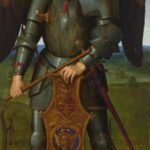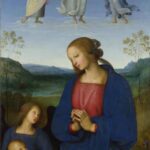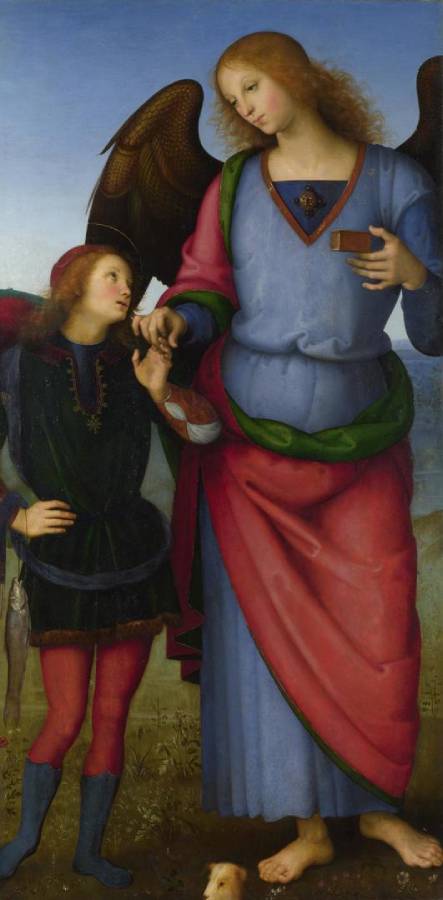Perugino (c.1446-1523)
L’Arcangelo Raffaele con Tobia (The Archangel Raphael with Tobias)
c.1496–1500
Oil and egg temera on poplar, 113.3 x 56.5 cm
National Gallery, London
This was the right panel of the predella of an altarpiece made for the Duke of Milan, Ludovico Sforza.
Altarpiece, Certosa di Pavia (c.1496-1500)
This panel is one of three that come from the lower tier of an altarpiece made for the Duke of Milan, and shows the Archangel Raphael, hero of the apocryphal Book of Tobit in the Old Testament.
The book is named after a blind old man, Tobit – a merchant and devout Jew – who sent his son Tobias on a long journey. Raphael was sent to accompany the boy, disguising himself as one of his relatives. An expansive landscape was an appropriate background to the subject, and here it is a continuation of that in The Virgin and Child with an Angel and The Archangel Michael.
Tobias holds a freshly caught and gutted fish: Raphael had instructed him to keep its heart, liver and gall. According to the text, Raphael explained that these could be used as an ointment to cure blindness and burnt to drive away evil spirits. He holds the precious organs in a little box. The pair were joined in their travels by Tobias’s dog. We can only see its head at the bottom of the panel, as the lower edge – like that of the other panels– was cut down in the eighteenth century.
Perugino was well known for his ‘sweet’ style, which is particularly apparent here in the look Tobias and Raphael share and in the way they tenderly grip each others’ fingers. He planned their poses in a drawing from life (using workshop assistants) now in the Ashmolean Museum, Oxford. The fish is painted with great skill – Perugino has taken particular care to show the faceted structure of the gill, and the sheen of its finely freckled silvery scales. As in the other panels, this naturalistic effect is achieved through his expert blending of oil paint.
Unlike Verrocchio’s version of the same subject, Perugino’s picture does not show the figures wearing the latest fashions – the emphasis is on Raphael’s protection of the boy. This is because the panel was made to celebrate Raphael, who takes his place in the altarpiece along with his fellow archangels: Michael on the left panel in the same tier and – Gabriel in the upper tier (now in the Musée d’Art et d’Histoire, Geneva). (NG)
Left panel:
 Perugino (c.1446-1523)
Perugino (c.1446-1523)
L’Arcangelo Michele
c.1496–1500
National Gallery, London
Central panel:
 Perugino (c.1446-1523)
Perugino (c.1446-1523)
Madonna col Bambino e un angelo
c.1496–1500
National Gallery, London
Perugino painted this altarpiece for the Duke of Milan, Ludovico Sforza (known as il Moro). He had been recommended by the Duke’s agent, who described him as ‘an exceptional master [whose] works have an angelic and very sweet air’.
The picture stood upon the altar in the side chapel dedicated to the Archangel Michael in the Carthusian monastery (also known as a charterhouse or certosa) in Pavia, a town outside Milan where the Duke had his palace. Our panels formed the lower tier of two in this large-scale construction. The upper tier showed the Annunciation: the Archangel Gabriel, on one panel, giving the Virgin Mary, on another panel, the news that she would conceive the son of God. Between these panels was an image of God in glory, which is still in the church.
It seems that the Duke was not happy with the length of time that Perugino was spending on the paintings – he wrote to his agent in 1499 demanding that he set the painter a deadline. Shortly afterwards, however, the Duke was captured by invading French forces, and the altarpiece was completed in the early sixteenth century by two other painters: Fra Bartolommeo and Mariotto Albertinelli.
The painting is an excellent example of Perugino’s skill in working with oil paint. According to Vasari, the sixteenth-century biographer of artists, he was praised for his ‘harmonious blending of colours’; painters travelled from as far as France, Spain and Germany to see his work. This was due to his knowledge of the Netherlandish technique of painting in oil, which was renowned for being incredibly sophisticated. The skin, for example, was painted using thin layers of paint, taking advantage of the white ground covering the panel to make the flesh appear pale. More generally, using oil enabled him to create a depth of colour by layering different tones, using translucent glazes which modified the colours beneath. It is possible that his talent at painting in oil was due to a visit to Venice in 1495 – artists there were more expert in the medium than in central Italy, where he was trained.
The pictures were removed to the picture gallery in Milan in the late eighteenth century, at which time copies were made. By the time they were purchased by the National Gallery in the mid-nineteenth century they had been cut down in various places, and all of them at the bottom edge. Fortunately, their original appearance is preserved in the copies which remain in the monastery. The central panel of the upper tier is also still in the church, surrounded by two paintings by Ambrogio Bergognone that originally belonged to a different altarpiece. (NG)
See also:
• Sforza, Ludovico il Moro, Duke of Milan (1452-1508)

